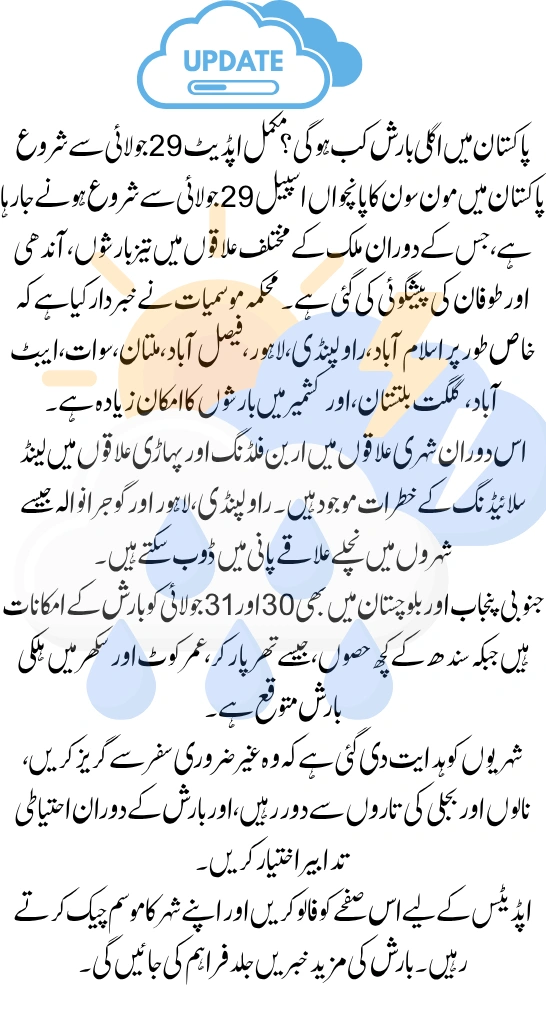Pakistan is bracing for another strong wave of monsoon activity as the weather turns increasingly unpredictable from July 29 onwards. The Meteorological Department has issued early alerts, forecasting widespread rains, thunderstorms, and strong wind gusts in several regions of the country. If you’re living in the north, traveling to the hills, or located in low-lying urban areas, now’s the time to get prepared.
The upcoming spell is expected to be the fifth major monsoon wave this season. While many welcome the cool breeze and relief from the summer heat, the intensity of this rainy wave brings risks—flash floods, landslides, road blockages, and urban flooding.
Which Areas Will Be Most Affected?
Also Read
Starting July 29 through July 31, heavy rainfall is expected in:
-
Punjab (including Lahore, Rawalpindi, Multan, Faisalabad, and D.G. Khan)
-
Islamabad and Rawalpindi
-
Khyber Pakhtunkhwa (Peshawar, Swat, Dir, Mansehra)
-
Gilgit-Baltistan and Azad Kashmir (Skardu, Hunza, Muzaffarabad)
-
Northern Balochistan (Zhob, Quetta, Khuzdar)
-
South-East Sindh (Tharparkar, Umerkot, Sukkur – limited rain chances)
These areas may experience scattered thunderstorms, short bursts of intense rain, and gusty winds, especially during afternoon and nighttime hours.

What You Should Expect
During this rainy spell:
-
Urban flooding may disrupt roads and drainage systems in cities like Lahore, Sialkot, Gujranwala, and Islamabad.
-
Flash floods are likely in hilly streams and riverbeds in KP, Balochistan, and Northern Punjab.
-
Landslides and road blockages are a concern for tourists heading to Murree, Galiyat, Kaghan, Babusar, and Gilgit-Baltistan.
-
Power outages, roof collapses, and infrastructure damage may occur in flood-prone districts.
Safety Measures for Citizens
To stay safe during this intense weather:
-
Avoid non-essential travel, especially toward hilly or flooded regions.
-
Do not cross flooded roads, streams, or nullahs—even a few inches of moving water can be dangerous.
-
Stay away from electric poles, billboards, and weak buildings during heavy winds.
-
Keep emergency kits, flashlights, and clean water ready in case of blackouts.
-
If you’re a farmer, secure your crops and livestock in higher ground.
Families living in mud or weak-structured houses are urged to be extra cautious. Secure rooftops and repair water leakages immediately to avoid accidents.
Climate Change Making It Worse?
Pakistan’s monsoon season has grown more intense in recent years, with frequent spells of torrential rains and flash floods. This isn’t just about weather—it’s a climate warning.
Glacial melt in Gilgit-Baltistan and increased cloudbursts due to rising global temperatures are now common. As a result, remote regions often get cut off after landslides and flooding. Emergency flights and rescue operations are becoming routine in high-altitude valleys.
Local authorities are reviewing early warning systems and disaster response planning to reduce damage and protect communities in vulnerable zones.
Final Thoughts: Be Weather-Wise
The next few days demand awareness and caution. Whether you’re a commuter in Lahore, a tourist in Hunza, or a shopkeeper in Dera Ghazi Khan—the rain may come hard and fast. Be smart, stay informed through trusted weather updates, and follow local advisories.
We’ll keep updating this page as new weather developments come in. Until then, stay dry, stay safe, and take no risks when it comes to rain!


![Today Qatar Riyal To Pakistani Rupees (QAR to PKR) – 24 July 2025 [Updated]](https://cbf.com.pk/wp-content/uploads/2025/07/Today-Qatar-Riyal-To-Pakistani-Rupees-QAR-to-PKR-–-24-July-2025-Updated-300x164.webp)
